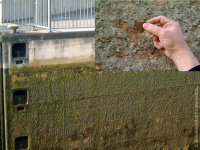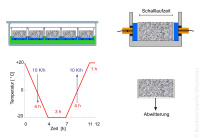Assessing the Freeze-Thaw Resistance of Concrete
From BAWiki

Hydraulic concrete structures are subject to particularly extreme freeze-thaw attack (see picture 1) due to freeze-thaw cycles depending on operation and tides and also because of the high degree of saturation resulting from direct exposure to water. To ensure sufficient durability considering the increased requirements [compared to DIN 1045] concerning service life, concrete source materials and concrete composition additional freeze-thaw laboratory tests are conducted.
The BAW has worked intensely, together with the University of Essen, on defining a freeze-thaw laboratory test and elaborating test criteria relevant for hydraulic engineering. In parallel with these efforts, the BAW is also conducting extensive studies, in collaboration with RWTH Aachen University, on the actual temperature and moisture levels in concrete structures in order to be able to transfer the results obtained from freeze-thaw laboratory tests to practical conditions.

The BAW Code of Practice "Freeze-Thaw Testing of Concrete" which was issued in 2004 governs frost resistance tests and related test criteria. The frost resistence test method selected is the CDF/CIF method (CDF: Capillary suction of Deicing solutions and Freeze-thaw test; CIF: Capillary suction, Internal damage and Freeze-thaw test); the acceptance criteria relate to the change of the dynamic modulus of elasticity as an indicator of internal damage and the sealing of material from the area exposed to freeze (picture 2). The acceptance criteria apply to test specimens cured according to the BAW Code of Practice. Further investigations will be required for the evaluation of core samples from structures.
The BAW's Supplementary Technical Contract Conditions applicable to new hydraulic structures (ZTV-W LB 215) and to the repair of existing hydraulic structures (ZTV-W LB 219) make reference to the BAW Code of Practice "Freeze-Thaw Testing of Concrete". Based on this Code of Practice, freeze-thaw and freeze-thaw de-icing salt resistance tests of concrete are, however, not only conducted in hydraulic engineering but also in many other engineering areas. The DIBt has also adopted the BAW Code of Practice for its own approval procedures.
back to: Structural Engineering Methods
